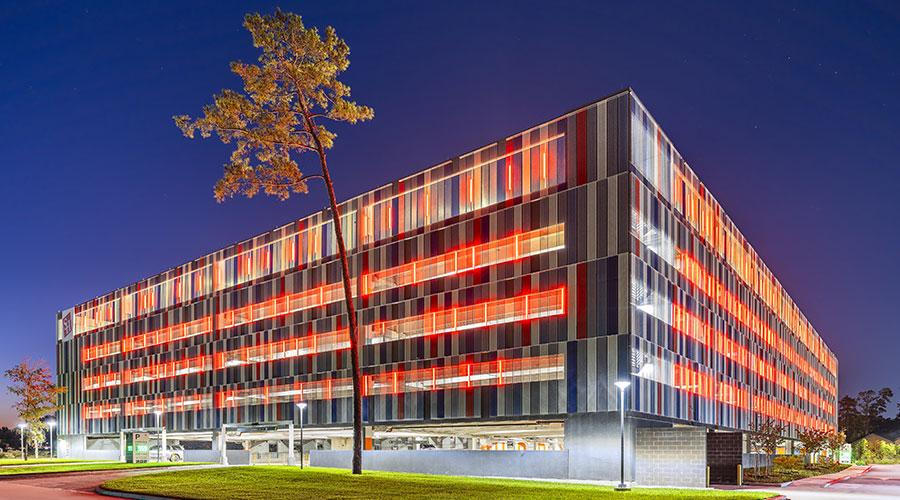Charting a Lighting Maintenance Initiative
Bonus Web Coverage: Lighting Resources
When lighting’s good, the customer or employee rarely notices it. But when lighting becomes too dim, causes glare or distorts the color of merchandise, everyone starts noticing. While good lighting often saves energy, bad lighting often shows up as a redline item on the organizational spreadsheet.
Coined by the National Lighting Bureau (NLB), high-benefit lighting (HBL) is an energy-efficient lighting system that gives people the light they need to do their jobs and generates bottom-line and other benefits. The dollar value of such benefits could be worth as much as a theoretical energy cost savings of 500-1,000 percent or more.
According to Getting the Most from Your Lighting Dollar, published by the National Lighting Bureau and available for free download at the NLB web site, managers can use lighting to improve the bottom line in the following ways:
-
Productivity improvements, due to workers’ ability to perform faster; also,
-
Building value enhancement, resulting, in part, from enhanced image and curb appeal, which are particularly important for leased properties.
-
Improved customer satisfaction and higher occupancy rates with less tenant turnovers.
-
Increased retail sales.
-
Safety/security improvements that impact liability loss prevention and lower insurance costs.
-
Low-cost space differentiation, particularly important in open-landscaped offices, department stores and similar facilities.
-
Space change flexibility, by taking advantage of luminaires that allow repositioning or re-aiming, and controls that can change luminaire light output.
-
Less downtime.
-
Tax benefits, particularly for using flexible lighting systems.
-
Utility cost savings, due to a more productive work force and by capturing lighting heat to supplement space heating and preheat domestic hot water.
-
Pollution prevention.
Lighting’s Impact
“Lighting is essential to the performance of every visual task in the building, and almost every task in the building is visual, except those that can be performed with eyes closed,” says John P. Bachner, NLB’s director of communications.
Certainly, the lighting in a building affects a manager’s tasks. But lighting also directly affects maintenance operations.
“The type of lighting system installed in a facility will definitely determine the ease of its maintenance, both in terms of the products and/or labor skills required for its support,” says Doug Stoneman, senior product manager for Advance Transformer Co. “The flexibility of the lighting system also will impact the degree of ease with which the facility can modify its lighting to support different tasks.”
Steve Goldmacher, director of corporate communications for Philips Lighting Co., suggests keeping the bigger picture in mind when making cost decisions.
“Of the annual amount spent on lighting, the percentage for lamps is just 3 percent,” Goldmacher says. “About 11 percent of lighting costs are spent on maintenance, changing lamps and cleaning systems. The majority, 86 percent, is spent on energy. So, saving a penny or two on a lamp doesn’t make sense in the grand scheme of profitability.”
Conventional lighting uses one of six lamp types: incandescent, fluorescent, mercury vapor, metal halide, high-pressure sodium, or low-pressure sodium. Efficiency is measured as efficacy.
Other issues include rated life, useful life — keeping lamps in place until they burn out usually is counterproductive — lamp lumen depreciation, color temperature, color rendition, and luminaire compatibility.
“Popular lighting trends within commercial and other facilities include the conversion from older T12 fluorescent systems driven by magnetic ballasts to more efficient T8 fluorescent lamps and electronic ballasts,” Stoneman says. “Electronic HID lighting sources also have become increasingly popular.”
A luminaire is a complete lighting unit, which includes lamps, ballasts, lamp holders, reflectors, and shielding or diffusing media. The efficiency of a luminaire is expressed as a ratio between its light output and the light output of the lamps it houses. Other considerations with luminaires include visual comfort probability, luminaire dirt depreciation, maintainability, shielding and diffusing media, ballasts and reflectors.
Lighting Controls
Smart lighting controls can be integrated into building automation systems. Other controls include stand-alone automated systems and multi- function programmable controllers, time switches, photosensor controls, photosensor-time-switch combinations and photosensor-dimmer controls, time-switch-dimmer controls, occupancy sensors and various manual controls.
“Most pervasive are occupancy sensors,” says Tom Leonard, director of marketing for the lighting control division of Leviton Manufacturing Co. “They have the lowest first cost and are the easiest to install. In addition, they deliver a measurable and immediate return on investment.”
Leonard says occupancy sensors use two main technologies: passive infrared and ultrasonic. The sensors can be combined with logic to create smart occupancy sensors that reach conclusions about the occupancy of the space rather than just respond to any movement in that area.
For managers interested in using controls for energy savings to improve their bottom lines, Tom Myers, senior sales manager of corporate accounts for Lutron Electronics Co., says, “Smart time clocks can automatically adjust the control of lighting for sunrise, sunset, daylight savings time, etc.”
Maximizing Performance
“The performance of lighting relates directly to the performance of the people that the lighting was installed to serve,” Bachner says. “From an economic viewpoint, when human productivity is optimized, the cost of lighting is minimized.”
Regular maintenance, group relamping and keeping fixtures clean are three simple ways to maximize lighting performance in any facility. A recent study by the interNational Association of Lighting Maintenance Companies (NALMCO) found that total lighting costs can be reduced by as much as 10 percent by cleaning the dirt from lighting fixtures regularly.
“The main benefit of lighting management is that you keep all the lights lit as they were originally designed to give optimum light to the building occupants,” says Cary Mendelsohn, owner, Imperial Lighting Maintenance Co.
“Lighting performance can be defined several ways,” says Myers. “Performance can be measured in watts per square foot, or footcandles, but it also needs to be measured in terms of occupant satisfaction. In many office spaces, for example, the majority of use is during the day when a significant amount of the desired footcandles are provided as daylight coming in through the window,” he says.
“If those people also are sitting under 40 footcandles of overhead lighting, we are not optimizing their comfort and wasting energy. By 3 or 4 o’clock, those people are fatigued, and they probably are not aware that the fatigue is caused by their eyes handling too much light. During daytime hours, they need the ability to dim or turn off the lights when there’s enough daylight available.”
Says Sri Rahm, senior application specialist for the GE Lighting Institute, “Lighting costs are made up of four components: energy, maintenance, disposal costs and hardware. By hardware, I mean fixtures, lamps, ballasts and controls. These costs are interdependent. You can reduce energy consumption by spending more on lamps, ballasts and controls. You can reduce maintenance labor by doing group relamping, which increases lamp costs; and so on. Decisions must be made with the broadest perspective in mind and the full understanding of costs and benefits involved...”
“Additionally, lighting impacts air conditioning loads and peak electrical demand. By monitoring and controlling electricity usage with microprocessors and managing electric loads intelligently, it is possible to optimize usage and reduce energy costs.”
Facility-specific Priorities
In lighting, one size or type of lighting does not fit all needs equally.
“You need to understand what is going on in a building,” Goldmacher says. “Even in an office building where fluorescents often are used, you have different needs for different locations. For example, if you have a section where computers are being used, you want to make sure there’s no glare on the screen. If color is important, then metal halides probably should be considered.”
In retail establishments, Goldmacher says a combination of lighting types might be used, with one type offering general lighting and spot or flood halogens used to highlight items. Even among similar building types, such as restaurants, bright lighting and hard seats will encourage customers to eat and leave quickly, while lower light levels and softer seating will encourage customers to linger.
“With lighting, you can set moods, move people in and out of places, depending on your corporation’s needs,” he says.
A primary lighting strategy used in various commercial and retail applications is combining T8 lamps with instant-start electronic ballasts, says Robert Weathers, head of new business developments for Sylvania Lighting Services. But as energy prices rise, many facilities turn to controls such as occupancy sensors to keep lighting energy use to a minimum. But it is important to look at many factors before just randomly installing controls.
“The instant-start family of ballasts is hard on lamps when they are rapidly turned on and off,” Weathers says.
The problem is the heavy current involved in the instant-start ballasts significantly shortens the life of the lamp. So, for bathrooms and other areas where people might enter and exit a lit area rather quickly and repeatedly, Weathers says rapid-start ballasts are a better option.
“Rapid-start ballasts heat up more slowly and give a softer start to the lamp, so that the constant on-off doesn’t have as much impact on lamp life,” he says.
Lighting Design
Good lighting is tailored to the needs of the space and the functions of the people occupying that space. Even when looking at similar office space, the lighting chosen might be very different, says lighting consultant Scott M. Watson, IALD, LC.
“We need to consider the ceiling height, the colors used in the space, what’s actually happening in that space, and whether the fixtures are recessed or hang down,” Watson says. “Then, we also must consider the style and wants of the client. For example, the federal government has detailed guidelines that spell out how much light must be in the space.
“There must be enough lighting to do the task. And, that seems to be where mistakes are frequently made.
Says Bachner, “In the vast majority of facilities, the subject of lighting is linked to the subject of energy saving, which is linked to cost reduction. This is not the way to do it. Lighting is not installed either to increase or to reduce energy consumption. Lighting is installed to help people get their work done.”
Before managers can realize maintenance benefits, Bachner suggests a five-step evaluation program.
“First, you need to be familiar with the types of lighting installed in your facilities,” he says. “Second, you need to know when they achieve that point in their use when their efficiency begins to decline rapidly. Third, you need to replace lamps before they burn out to boost your average light output over time and to minimize energy costs on a per-lumen basis. Fourth, all lamps need to be replaced on a group relamping basis to minimize labor requirements, storage requirements and shrinkage requirements, and to maintain a uniform appearance on the ceiling.
“Fifth, identify conditions so that you establish an effective cleaning schedule for regularly cleaning lamps and luminaires, and then implement that schedule.”
Proven Techniques
Besides cleaning lamps and luminaires, group relamping and lighting audits also are proven money savers as part of planned lighting maintenance.
NLB recommends conducting a lighting system audit to document the types of lighting being used in the building, how each is performing, and current maintenance practices. Lighting consultants, independent contractors, product manufacturers, or in-house personnel — provided they have been properly trained and have the necessary equipment — can perform such audits.
Lighting: The Outside Story
Outdoor lighting is the most effective and least expensive form of security. Unlike security personnel, closed-circuit television, sensors and detectors, and other security systems and devices, electric illumination is highly visible. The same lighting needed to provide security and safety can be used to provide identification, environment integration, beautification, attraction and even recreation.
When profit-making organizations invest in effective security lighting, they do so to cut actual or prospective losses. So while the lighting might be an expense, it can reduce the lost profits that can result when safety is somehow breached. When a comprehensive analysis is performed, however, so that all of lighting’s effects are considered and steps are taken to derive more benefit from each, a different scenario emerges. Of course, there is nothing wrong with lighting that helps assure profitability by preventing losses. Consider, however, that the same lighting system can do so much more by maintaining or enhancing image, improving curbside appeal, increasing building value, and so on. These other benefits are very real and can be obtained with relative ease.
In the case of public or other not-for-profit entities, profit is not the appropriate word, at least not in the business sense. However, in the sense that profits means benefit, the same basic concepts apply. In essence, one can realize tremendous benefit from security lighting.
Excerpted from Lighting for Safety and Security, published by the National Lighting Bureau.
|
Rita Tatum is a freelance writer specializing in facilities management topics.
Related Topics:











